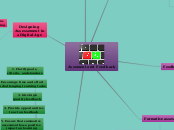
Assement and Feedback
Is a practice that equips learners to study and perform to their discipline
Benefits
Increased opportunities for learners to act on feedback
Immediate feedback

Choice in the timing and locations assessments.
Variety and authentic in the design of assessments
Enabling learner to measure their understanding
Multimedia technologies make feedback more personal
Through



Approaches to assessment
Associative
Perspective
Emphasises that learning is about
acquiring competence, through concept linking together component skills

Proyect Work
Constructivist
Perspective
Emphasises on learners must actively construct their own understanding

Experimentation
Social Constructivist
Perspective
Emphasises on the
role of others in
constructing
understanding

Dialogue
Situative Perspective
Emphasises on sees learning
as arasing from participation
in commnities to practice

Role Play Activity
Feedback
Is the effective assessment to encorage
to spend time and effort

In
Out
across
Comes from:

Practitioner

Learners
Peer assessment
Formative assessment
“Are activities that allow learners & practitioners to monitor learning.” (Nicol & Macfarlane-Dick, 2006).
Using
7 principles of
good feedback
1. Clarify what good
performance is.
2. Facilitate reflection &
self-assessment
3. Deliver high-quality
feedback to help
learners self-correct
4. Encorage practitioner
and learners dialogue
5. Encorage positive
motivational beliefs
6. Opportunities to act
on peer feedback
7. Use feedback from learners
to improve teaching
Designing
Assessement in
a Digital Age
Requires the
understanding of
the relationship of
Assessment
Feedback
Effective
Learning
12 Principles
1. Clarify goals,
criteria. and standars
2. Encourage time and effort
on challenging learning tasks
3. Give high
quality feedback
4. Provide opportunities
to act on feedback
5. Ensure that summative
assesment has a positive
impact on learning
6. Encourage interaction
around learning
7. Facilitate the development
of self-assesment and
reflection in learning
8. Give choice in the
topic, method, criteria,
weighting or timing of
assesments
9. Involve learners in
making about assessment
policy and practice
10. Support learning groups
and learning comunities
11. Encourage positive
motivational beliefs and
self-esteem
12.Provide information to
teachers that can be used
to help shape their teaching
Also
Programme
of Study
through
Clear instructional tasks
To
Empower

Engage

Acquire
evaluative skills
self -assess
Improved
by
Technology
Designed
with
Purpose
Adaptability
Familiarty
